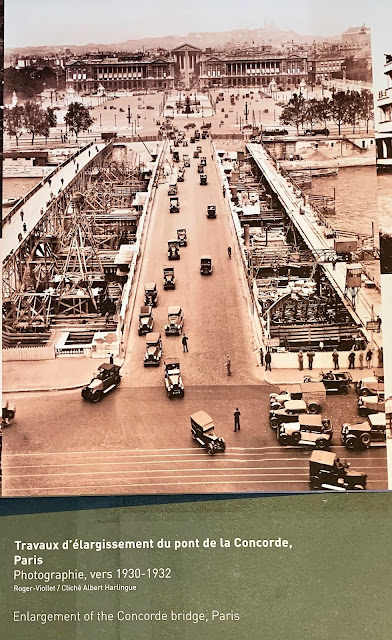A while ago, we visited the Pavillon de l'Arsenal, a museum opened in 1988 that is dedicated to urbanism and architecture of Paris.
The building sits on the former site of a gunpowder factory near the Seine river in the 4th arrondissement. The building, completed in 1879, initially housed the art collection of a wealthy Parisian merchant. It had different uses over the decades--a warehouse for a time and also an archive.
We visited the museum because we love Paris and architecture. So, the marriage of the two--Parisian architecture--made a visit inevitable. We enjoyed touring the museum and learning more about one of our favorite cities.
In the center of the building, a video map on the floor moves and magnifies images of Paris. Below, Marie-Chantal points to our apartment building.
The museum has many vintage photos of Paris in the past. Below, a 1971 photo depicts the demolition of Paris' fresh food market, Les Halles. (Saint-Eustache is the church in the background.) A market had been located there for centuries. In 1969, it was moved 11 miles to the edge of Paris.
Jean-Claude is fascinated by glass houses and modular houses. Below is a 1956 design for a glass walled, modular house.
Another interesting exhibit was about bridge construction. The Pont de la Concorde crosses the Seine not far from our apartment. Today, the bridge is very wide, with lanes for cars and buses and wide sidewalks for pedestrians like us. Up until 1932, the bridge was 1/3 of its present size. Below, you can view a photo of the bridge during construction. In the distance you can see the obelisk in the center of the square and the Madeleine church beyond the obelisk.
Speaking of the obelisk, below is a painting that depicts raising the obelisk into its vertical position.
Jean-Claude loves maps, especially maps of places included in the 10 Year Plan. Below is a relief map depicting the center of Paris today. The Louvre is visible, as is the Tuileries garden to the left. The red arrow point to our apartment building.
In the 12th arrondissement, hundreds of wine warehouses used to hold Paris's huge supply of wine next to Seine. The warehouses were shut down and, starting in the early 1980's, the area was transformed. A park was added, along with apartment and office buildings, plus an arena and shopping area. The photo below depicts the area today. We have visited several times during Year 2.
The architecture of the Pavillon de l'Arsenal (pictured below) has interesting features, such as large windows for lights and decorative iron framework.
 |
| Upper floor of the Pavillon de l'Arsenal |












No comments:
Post a Comment